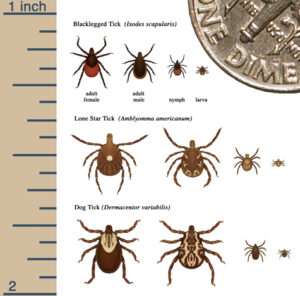Call for your appointment today 914-666-4665 | Mt. Kisco, New York

“While questing, ticks hold onto leaves and grass by their third and fourth pair of legs. They hold the first pair of legs outstretched, waiting to climb onto the host,” according to researchers from the Centers for Disease Control and Prevention (CDC). “When a host brushes the spot where a tick is waiting, it quickly climbs aboard.” [2]
 In a recent study, Arsnoe and colleagues looked at the questing behavior of nymphal ticks in Michigan and Tennessee by examining the number of ticks that would climb a wooden dowel. [3]
In a recent study, Arsnoe and colleagues looked at the questing behavior of nymphal ticks in Michigan and Tennessee by examining the number of ticks that would climb a wooden dowel. [3]
They found that the nymphal ticks in Michigan were 8 times more likely to climb the dowel than the nymphal ticks in Tennessee.
Why would the southern ticks not climb so high and exhibit lower questing behavior? The authors discussed 3 possible reasons:
- Ticks in the South are trying to avoid desiccation.
- Ticks in the South have access to a blood meal below the leaf litter by feeding on skinks.
- Southern ticks are different than northern ticks.
If their findings are confirmed that northern ticks do, in fact, behave differently than ticks in the South, the authors have introduced a new concern for residents in that region.
“I. scapularis populations infected with B. burgdorferi s.s. have been detected in four eastern [Tennessee] counties, we speculate that the eastern part of that state has become a transition zone,” writes Arsnoe and colleagues, from the Department of Fisheries and Wildlife at Michigan State University.
This geographic expansion “could lead to increased incidence in southern states of Lyme borreliosis and other diseases vectored by this tick, if the ‘northern’ host-seeking behavior of immigrant nymphs is retained,” the authors explain.
Related Articles:
Southern nymphal deer ticks in hiding?
Kentucky is swarming with deer ticks: Over 50% of the counties infested
References:
- Arsnoe, I.M., Hickling, G.J., Ginsberg, H.S., McElreath, R., Tsao, J.I., 2015. Different
populations of blacklegged tick nymphs exhibit differences in questing behavior that
have implications for human Lyme disease risk. PLoS One 10, e0127450. - Ticks from CDC at https://www.cdc.gov/ticks/life_cycle_and_hosts.html. Last accessed 2/24/19.
- Arsnoe I, Tsao JI, Hickling GJ. Nymphal Ixodes scapularis questing behavior explains geographic variation in Lyme borreliosis risk in the eastern United States. Ticks Tick Borne Dis. 2019.



